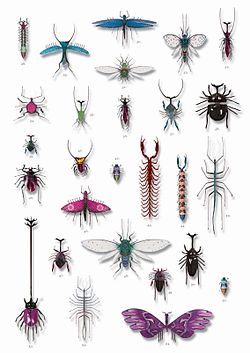Portal:Yorkshire
The Yorkshire Portal
Yorkshire (/ˈjɔːrkʃər, -ʃɪər/ YORK-shər, -sheer) is an area of Northern England which was historically a county. Despite no longer being used for administration, Yorkshire retains a strong regional identity. The county was named after its original county town, the city of York.
The south-west of Yorkshire is densely populated, and includes the cities of Leeds, Sheffield, Bradford, and Wakefield. The north and east of the county are more sparsely populated, however the north east includes the southern part of the Teesside conurbation, and the port city of Kingston upon Hull is located in the south-east. York is located near the centre of the county. Yorkshire has a coastline to the North Sea to the east. The North York Moors occupy the north east of the county, and the centre contains the Vale of Mowbray in the north and the Vale of York in the south. The west contains part of the Pennines, which form the Yorkshire Dales in the north-west. (Full article...)
Selected article

Guy Fawkes (13 April 1570 – 31 January 1606), also known as Guido Fawkes, the name he adopted while fighting for the Spanish in the Low Countries, was a member of a group of provincial English Catholics who planned the failed Gunpowder Plot of 1605.
Fawkes was born and educated in York. His father died when Fawkes was eight years old, after which his mother married a recusant Catholic. Fawkes later converted to Catholicism and left for the continent, where he fought in the Eighty Years' War on the side of Catholic Spain against Protestant Dutch reformers. He travelled to Spain to seek support for a Catholic rebellion in England but was unsuccessful. He later met Thomas Wintour, with whom he returned to England.
Wintour introduced Fawkes to Robert Catesby, who planned to assassinate King James I and restore a Catholic monarch to the throne. The plotters secured the lease to an undercroft beneath the House of Lords, and Fawkes was placed in charge of the gunpowder they stockpiled there. Prompted by the receipt of an anonymous letter, the authorities searched Westminster Palace during the early hours of 5 November, and found Fawkes guarding the explosives. Over the next few days, he was questioned and tortured, and eventually he broke. Immediately before his execution on 31 January, Fawkes jumped from the scaffold where he was to be hanged and broke his neck, thus avoiding the agony of the mutilation that followed.
Fawkes became synonymous with the Gunpowder Plot, the failure of which has been commemorated in England since 5 November 1605. His effigy is traditionally burned on a bonfire, commonly accompanied by a firework display. (read more . . . )
Selected image

Credit: Roger Kohn
Buggery by numbers 28-55-2 (2003) by Roger Kohn a York contemporary artist, author and art critic. (read more . . . )
Selected biography

Dench's more recent film career has been extremely successful. She successfully garnered six Oscar nominations in nine years for Mrs Brown in 1997; her Oscar-winning turn in Shakespeare in Love in 1998; for Chocolat in 2000; for the lead role of writer Iris Murdoch in Iris in 2001 (with Kate Winslet playing her as a younger woman); for Mrs Henderson Presents (a romanticised history of the Windmill Theatre) in 2005; and for 2006's Notes on a Scandal, a film for which she received critical acclaim, including Golden Globe and Screen Actors Guild nominations. In February 2008, she was named as the first official patron of the York Youth Mysteries 2008, a project to allow young people to explore the York Mystery Plays through dance, film-making and circus. (read more . . . )
Selected list -

The Churches Conservation Trust, which was initially known as the Redundant Churches Fund, is a charity whose purpose is to protect historic churches at risk, those that have been made redundant by the Church of England. The Trust was established by the Pastoral Measure of 1968. The legally defined object of the Trust is "the preservation, in the interests of the nation and the Church of England, of churches and parts of churches of historic and archaeological interest or architectural quality vested in the Fund ... together with their contents so vested".
The Trust cares for over 350 churches. The charity is financed partly by the Department for Culture, Media and Sport and the Church Commissioners, but grants from those bodies were frozen in 2001, since when additional funding has come from other sources, including the general public. During the 2016-2017 period, the Trust's income was £9,184,283 and expenditures totaled £9,189,061; 92% of the latter was spent on front line projects. During that year it had 64 employees, and received the support of up to 2,000 volunteers. The charity is run by a board of trustees, who delegate the day-to-day management to a chief executive and his senior management team. (Full article...)List of selected lists
|
|---|
Selected Did You Know . . .

- ...that John Harrison (pictured), seventeenth century benefactor of Leeds, is reputed to have slipped Charles I a tankard of gold coins disguised as beer?
- ... that Humphrey de Bohun, Earl of Hereford was allegedly killed by a spear through the anus at the Battle of Boroughbridge in 1322?
- ...that Ebenezer Rhodes, Sheffield's Master Cutler, was declared bankrupt after losing money publishing books about Derbyshire?
- ...that the 364-metre pier in Withernsea, England was struck by ships four times, finally leaving it only 15 metres long?
General images -
Subcategories
Selected panorama

Topics
Related portals
WikiProjects
Things you can do
Associated Wikimedia
The following Wikimedia Foundation sister projects provide more on this subject:
-
Commons
Free media repository -
Wikibooks
Free textbooks and manuals -
Wikidata
Free knowledge base -
Wikinews
Free-content news -
Wikiquote
Collection of quotations -
Wikisource
Free-content library -
Wikiversity
Free learning tools -
Wikivoyage
Free travel guide -
Wiktionary
Dictionary and thesaurus



















































